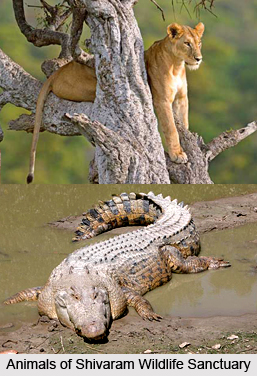 Shivaram Wildlife Sanctuary, situated in Karimnagar District, located in the newly formed Indian state of Telangana, is a heaven for nature and adventure lovers.
Shivaram Wildlife Sanctuary, situated in Karimnagar District, located in the newly formed Indian state of Telangana, is a heaven for nature and adventure lovers.
Shivaram Wildlife Sanctuary spreads along the banks of Godavari river and is famous for fresh water crocodiles. Apart from being the home to a vast variety of flora and fauna, the sanctuary is adorned with resplendent natural beauty.
Location of Shivaram Wildlife Sanctuary
Shivaram Wildlife Sanctuary in Telangana, a newly formed state in India, spans over an area of 36.29 square kilometres with a wildlife haven located at a distance of around 80 kilometres, 50 kilometres and 10 kilometres from Karimnagar, Mancherial and Manthani respectively. The most unique feature of the sanctuary is that it is a perennial basin in Godavari River and is the home to Marsh Crocodile or Mugger. In fact the sanctuary, Shivaram Wildlife Sanctuary was established in the year 1987, mainly with the aim of protecting and conserving crocodiles. At that time this wildlife sanctuary was mapped in Andhra Pradesh. But from the year 2014, this wildlife sanctuary is mapped in India`s newly formed state which is listed as 29th State in India, consisting of the ten north-western districts of Andhra Pradesh.
Fauna of Shivaram Wildlife Sanctuary
Shivaram Wildlife Sanctuary is a unique wildlife preserve which flaunts a number of exotic varieties of flora and fauna. The vegetation of the forest is mainly of deciduous type and comprises Kodsha, Terminalias, Gumpena, Timan, Teak and several thorny shrubs. It also shelters animals such as Nilgai, Chausingha, Sambar, Cheetal, Wild Boar, Sloth Bear, Rhesus Monkey, Langur, Panther, Python, Tiger and many more.
Crocodiles in Shivaram Wildlife Sanctuary
Numerous species of crocodiles form the major attraction of Shivaram Wildlife Sanctuary. Vast variety of crocodiles basking in the sun creates a delightful watch for the visitors. A fresh water crocodile called Mugger Crocodile is a common inhabitant of this sanctuary. These are the original inhabitants of the Indo-Gangetic Rivers such as Godavari River, which is known as River of the South. These Muggers have the capability of crawling for considerable distances on land which differentiates them prominently from salt water crocodiles. This special attribute of the fresh water crocodiles have made them a great attraction for the tourists.
Visiting Information
Winter is the best season to visit Sivaram Wildlife Sanctuary. It also forms an excellent destination for the dwellers around the sanctuary. Jeeps are available for an exquisite jungle safari which is a major attraction for the tourist and provides an exciting and adventurous expedition through the deep forest. Forest rest houses at Eklaspur and Mancherial are also available for an enticing stay amid the natural beauty.



















